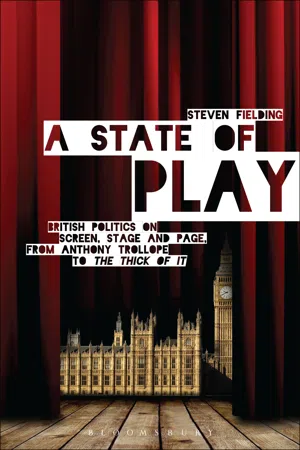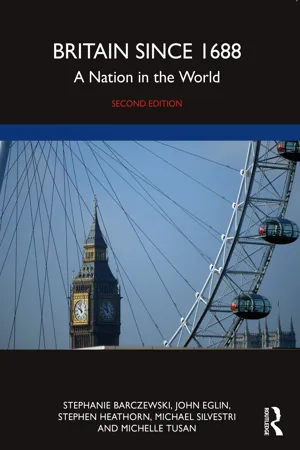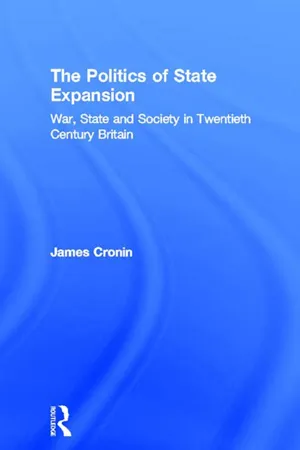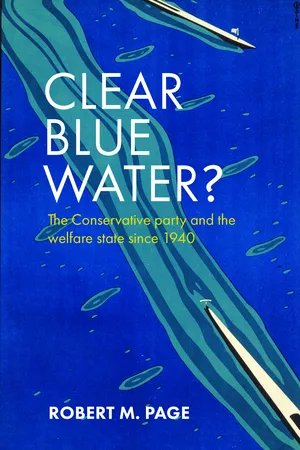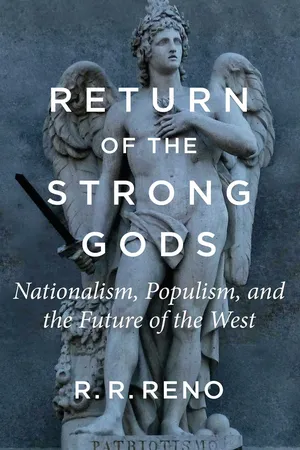History
Post War Consensus
The Post War Consensus refers to a period of political agreement and cooperation in the United Kingdom following World War II. It was characterized by a commitment to welfare state policies, nationalization of key industries, and a focus on social equality. This consensus was largely upheld by both major political parties and contributed to a period of relative stability and economic growth in the country.
Written by Perlego with AI-assistance
Related key terms
7 Key excerpts on "Post War Consensus"
- eBook - ePub
- Cliff Alcock, Guy Daly, Edwin Griggs(Authors)
- 2014(Publication Date)
- Routledge(Publisher)
Jones and Novak, 1980 ). The welfare state itself became regarded as a creature of consensus politics which, irrespective of their objective success or failure in meeting social need, was to be fostered, defended and extended as the mark of a civilised society. We shall, in the rest of this chapter, aim to untangle the conflicting arguments about the existence, nature and scope of the post-war British consensus.The consensus, so it was said, evolved from the aping, by the Conservative Chancellor of the Exchequer, Butler, of the economic policies of his Labour predecessor, Hugh Gaitskell. So clear was the belief in the consensus that it acquired its own identity in the phrase ‘Butskellism’. That the consensus existed appears to be in little doubt, since we are told that from the early 1970s it came under increasing strain in the austere economic climate of the day. Indeed we are further told that the consensus was responsible for many of the social problems visible in Britain in the 1970s and early 1980s.But the roots of this apparent consensus can be traced back to the inter-war years. The privations, at least for working people, of the 1920s and 1930s and the clearly polarised, along class lines, response of the government to that period of economic crisis, which sought to protect the owners of finance capital, were still clear in the post-war memory. In addition, the minority Labour governments of 1923 and 1929 appeared powerless to break free from the drive for profit of British capitalism. It was in this environment that the idea of a negotiated settlement between labour and capital, which would ensure steady economic growth but also alleviate the suffering of many, gained currency (Addison, 1975 ; Sked and Cook, 1979 ; Briggs, 1983 - eBook - ePub
A State of Play
British Politics on Screen, Stage and Page, from Anthony Trollope to The Thick of It
- Steven Fielding(Author)
- 2014(Publication Date)
- Bloomsbury Academic(Publisher)
4Imagining the Post-War Consensus
Many now look on the two decades immediately following the end of the Second World War as marking the zenith of Britain’s two-party system.1 The interwar coalitions, party splits and minority governments were no more, while Labour and the Conservatives enjoyed unprecedented support. At the 1950 general election eighty-four per cent of the electorate voted and of this number ninety-seven per cent chose one or other of the two parties who claimed to have a combined total of three million members. At this point Labour and the Conservatives appeared to hold a secure place in the people’s affections: as the political scientist Robert McKenzie concluded in 1955, they were ‘two great monolithic structures’ deeply embedded in society.2 More broadly, leading social scientists believed – encouraged by many Britons’ effusive reaction to the Coronation of Queen Elizabeth II in 1953 – that the rulers and ruled enjoyed a ‘moral unity’.3Most contemporaries also considered that the collectivist policies introduced by the 1945 Attlee government had solved Britain’s interwar economic problems. Due to this perceived success, the return of Churchill to Number 10 in 1951 did not inaugurate a significant change in policy even though many Conservatives harboured suspicions of the state. Full employment and rising living standards meant there was little reason to alter course. When Prime Minister Harold Macmillan claimed in 1957 that people had ‘never had it so good’, so far as the vast majority was concerned, he spoke the truth. As a consequence, many historians claim there was such an unusually high level of agreement that the two party leaderships formed part of what was in effect a policy ‘consensus’, which lasted until the 1970s.There was in fact a much broader and deeper consensus that underpinned this agreement on policy – one that had reigned for decades. While after 1945 the parties might still dispute the ultimate aim of politics (greater ‘equality’ for Labour or more ‘freedom’ for the Conservatives) there had long been harmony over the kind of democracy through which they pursued these aims. Indeed, both Front Benches so intently believed ‘politics’ to be a question of manipulating the existing Westminster model that they rarely discussed the matter. With Nazism defeated and Soviet Communism only appealing to a few thousand Britons, there appeared to be no alternative to the Westminster way and the rule of the party politician. Some expressed their adherence to this system beneath sardonic bon mots - eBook - ePub
Britain since 1688
A Nation in the World
- Stephanie Barczewski, John Eglin, Stephen Heathorn, Michael Silvestri, Michelle Tusan(Authors)
- 2023(Publication Date)
- Routledge(Publisher)
Six years after the end of the war, Britons were weary of seemingly endless austerity, and in the election of 1951, the Conservatives, still led by seventy-seven-year-old Winston Churchill, returned to power with a slim majority. The burden of austerity had fallen disproportionately on women, who usually managed rationing in the family, and a significant number of them voted Conservative due to their promises to begin a return to normal economic conditions. It is a measure of the popularity of the welfare programs that Labour had introduced, however, that the Conservative governments of the 1950s and 1960s made no attempt to scale them back. Postwar Conservative leaders recognized the claims of the “People’s War,” and they understood that they risked permanent removal from power if they tried to unstitch the new social safety net. Their embrace of this consensus allowed them to remain in power until 1964.For decades after the war the Conservative and Labour parties agreed on two basic issues. First, they agreed that the welfare state that had been created in the late 1940s was to be maintained. Second, they agreed that full employment and a mixed economy in which there was at least some degree of government intervention would remain the cornerstones of economic policy. Recent historical research, however, has reduced the areas of policy in which there was a real meeting of the minds between the two parties, and emphasized that there were many internal disagreements within them about what course to follow. Consensus should thus not be thought of as agreement between the parties about what programs and policies should be pursued, but rather as a working compromise that was dependent on the social and economic conditions of the time. There was, for example, clear disagreement between the two parties on the universalism of the welfare state. Labour generally wanted to eliminate means-testing so as to preserve cross-class unity, while the Conservatives wanted benefits to be targeted at only those in need. There was also disagreement on economic policy. The pursuance of full employment required the Conservatives to display a less antagonistic attitude towards trade unions than in the past. They also wanted less state ownership than did Labour, and thus for example moved to denationalize the steel industry in 1952. One of the most divisive of all consensus-era social policies was housing. Conservatives viewed the rights of private property as sacrosanct, while Labour saw them as potentially damaging to the economic interests of the working class. In some ways, the only real area of postwar consensus was in foreign policy. The Conservatives and Labour agreed that Britain should support the Commonwealth, move towards decolonization, oppose Soviet communism, retain membership in the North Atlantic Treaty Organization (NATO) and develop its own nuclear capability. Both parties were hostile to British involvement in European unification, which began via the European Defence Community in 1950, and both supported the “special relationship” with the United States. - eBook - ePub
British Culture of the Post-War
An Introduction to Literature and Society 1945-1999
- Alastair Davies, Alan Sinfield(Authors)
- 2013(Publication Date)
- Routledge(Publisher)
On the one hand, the Conservatives wanted to stay in power; on the other hand, there was also, on the postwar right as on the postwar left, a genuine acceptance of the fundamental principles of the postwar settlement. The detailed planning for the welfare state had taken place during the war-time coalition and had involved cross-party co-operation. The report on social welfare had been written by a prominent Liberal, Sir William Beveridge, while the committee reporting on education had been promoted by a prominent Conservative, R. A. Butler. By fostering a sense of national unity and an acceptance of the benefits of cen- tralised control, the Second World War was to change decisively the ideological terrain of postwar politics (Hennessy 1992; Addison 1994). Indeed, during the next three decades, the Conservative and the Labour parties won elections by persuading the electorate that they were the best equipped to make a success both of the welfare state and of the mixed economy. In the 1950s, Conservative governments (with the benefits of the postwar economic recovery) took credit for increasing levels of social welfare and completing ambitious targets for building council houses, schools and roads; in the 1960s, Labour governments (1964–66; 1966–70) made the modernisation of Britain their focus. Through increased government intervention in the mixed economy, the Labour Prime Minister, Harold Wilson, hoped to create a dynamic, technologically advanced economy; through increased spending on education (new universities, science-based polytechnics, the Open University and the compre- hensive school system) he hoped to create a better educated and more egalitarian society. The relative weakness of the British economy not only undermined these plans but also led to the first concerted challenge to the postwar consensus - eBook - ePub
The Politics of State Expansion
War, State and Society in Twentieth Century Britain
- James Cronin(Author)
- 2005(Publication Date)
- Routledge(Publisher)
Chapter 10
“Centring” the postwar settlement
THE CONSERVATIVES CONFRONT THE “POSTWAR SETTLEMENT”
The defeat of the Labour government in October 1951 brought to an end the most sustained effort to reshape the state in modern times. Labour left behind both an expanded set of public commitments to social and economic goals and a formidable array of agencies and policies with which to fulfil them. The commitments that Labour succeeded in grafting upon the state were not uniquely their own or entirely new in 1945. They consisted essentially of the promise that government would seek to provide work for all and a comprehensive system of welfare benefits as a matter of social right. Promises of this sort were implicit in Beveridge, in the rhetoric of reconstruction to which all parties contributed during the war and in the coalition’s postwar planning. But it was the Labour victory in 1945 and the party’s remarkable success in translating promise into legislation and, to a considerable extent, into economic performance that ensured that these commitments would become the cornerstone of public policy and of Britain’s political culture for at least three decades after the war’s end.The policy devices and instruments that Labour evolved and bequeathed to subsequent governments, and through which the state’s new-found responsibilities were to be discharged, were overall a less impressive achievement. Labour had worked hard at figuring out what mix of policies would be most effective at managing the economy, generating growth and improving the distribution of income and benefits, but it can hardly be said to have succeeded in finding that mix. Likewise, the politicians and officials who oversaw the expansion of government responsibilities during the 1940s sought at the same time to restructure the institutions of the state so as to ensure its capacity to deliver on its promises. But, again, they were not entirely successful: they failed to create a central mechanism for co-ordinating economic and social policy or to develop a set of practices that would ensure that what government decided at the centre would become reality throughout the land. - eBook - ePub
Clear Blue Water?
The Conservative Party and the Welfare State since 1940
- Page, Robert M., Robert M. Page(Authors)
- 2016(Publication Date)
- Policy Press(Publisher)
TWO From war to peace: the Conservatives and the welfare state in the 1940s The Conservative Party’s growing dominance in British politics was underlined at the 1935 General Election when the ‘National’ Conservative government was re-elected to office. The Conservatives secured 47.8% of the popular vote, returning 386 MPs to Westminster. Although Labour recovered from its disastrous showing in the 1931 General Election (when it was reduced to just 52 MPs), it only managed to win 154 seats on the basis of 38% of the popular vote. It was acknowledged within Labour circles that there was limited prospect of the party making significant inroads into the Conservative vote by the time of the next General Election in 1939 or 1940. However, the outbreak of the Second World War disrupted the domestic political scene and proved to be a catalyst for a dramatic revival in the fortunes of the Labour Party. In this chapter, attention will be focused, first, on the impact of the Second World War on the Conservative Party’s approach to social policy during the period of coalition government from September 1940 until 1945. Attention will then shift to the growing influence of progressive ‘One Nation’ Conservatism towards the end of the war, which was to underpin the party’s peacetime thinking on the welfare state from the early 1950s to the mid-1970s. Conservative social policy during the Second World War Labour’s decision to join the coalition government in 1940, which was conditional on Neville Chamberlain relinquishing his position as Prime Minister, 1 had a significant impact on the Conservative Party’s approach to social policy for the remainder of the war and beyond. Labour’s willingness to join the coalition was premised on a clear understanding that there would no longer be an exclusive focus on the military campaign. At Labour’s insistence, post-war reconstruction was to be moved up the political agenda - eBook - ePub
Return of the Strong Gods
Nationalism, Populism, and the Future of the West
- R. R. Reno(Author)
- 2019(Publication Date)
- Regnery Gateway(Publisher)
HAPTER ONE The Postwar ConsensusO n October 1, 1990, George H. W. Bush addressed the United Nations General Assembly in New York. A veteran of World War II, the American president recalled “the fires of an epic war” that “raged across two oceans and two continents.” For the men who led the Allied forces and those who fought under them, preventing a return of global conflict was an overriding imperative. The leaders of the triumphant forces gathered in San Francisco in June 1945 to adopt the charter of the United Nations. As Bush recalled, their goal was “to build a new kind of bridge: a bridge between nations, a bridge that might help carry humankind from its darkest hour to its brightest day.”The Cold War dampened the promise of those hopeful early days after Germany and Japan had gone down to defeat. The long struggle to contain Soviet aggression required the postwar generation to defer its hopes for the inauguration of a new era of global cooperation and peace. But the wheel of history turned yet again. “The Revolution of ’89 swept the world almost with a life of its own, carried by a new breeze of freedom,” Bush told the delegates gathered from around the world. Some still resisted the spread of liberty. Saddam Hussein’s Iraq had recently invaded Kuwait, annexing that sovereign nation in a manner reminiscent of Hitler’s aggression in the 1930s. Bush assured the world that the United States would not stand idly by. He promised to fight for “a new and different world.” Dictators would not be permitted to control the future. The president raised his eyes to take in a bright new horizon: “I see a world of open borders, open trade, and, most importantly, open minds.”This charming formulation was not a novelty in 1990. It expressed the essence of the West’s postwar consensus. The history of the first half of the twentieth century seemed to speak for itself: German militarism and the seduction of aggressive nationalism caused World War I; in the social disorder that followed the armistice, Mussolini rose to power as the supreme leader of a paramilitary political party; Nazism combined anti-Semitic animus with a cruel ideology of strength; and, of course, communism governed in the Soviet Union for decades, feeding on the same totalitarian temptations. The inescapable lesson, most came to believe, was that war and destruction arose from close-minded modes of life and thought.
Index pages curate the most relevant extracts from our library of academic textbooks. They’ve been created using an in-house natural language model (NLM), each adding context and meaning to key research topics.

